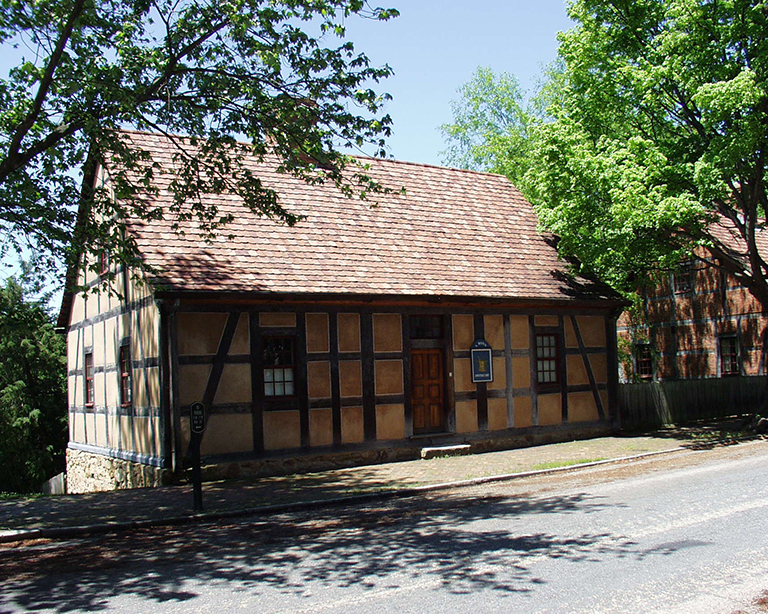Reuter, Christian Gottlieb (1717-1777)
Birthplace:
Germany
Residences:
- Bethabara NC, Winston-Salem NC
Trades:
- Architect
NC Work Locations:
Building Types:
Christian Gottlieb Reuter (September 5, 1717-December 30, 1777), a German-trained surveyor and later a building designer, was one of the most influential forces in the development of the appearance of the towns as well as the land use patterns of the Moravian tract called Wachovia in piedmont North Carolina. (See Frederick William Marshall for an account of the Moravians in North Carolina and the Wachovia settlement.) In addition to mapping the tract and drawing up town plans for Bethania, Bethabara, and Salem, Reuter planned the first five timber houses in Salem as well as other early buildings there.
The son of a surgeon, Christian Reuter was born in Steinbach in present Germany. During his youth, his family lost most of its wealth and moved frequently throughout Germany. In 1732 young Reuter was apprenticed to the surveyor Franz in the service of Count Erpach. After completing his apprenticeship, Reuter won his certificate, went to work for Prince Hanau, and at age twenty-one was appointed royal surveyor. Deeply religious, he joined the Moravian church and in 1756 accepted a call to assist the Moravians in America with their surveying needs. He spent two years in the Bethlehem, Pennsylvania, area, where he designed the Sun Inn and laid out the town plan for Lititz, Pennsylvania.
He was soon assigned to the Wachovia Tract, where he arrived in the initial village of Bethabara in July 1758. Working as part of the highly disciplined Moravian community, he quickly set about surveying the 98,985-acre Wachovia Tract, paying close attention to topography and vegetation as well as boundary lines. He produced several maps, including the “Great Map of 1762,” which is over 9 feet long and 7 feet high with a scale of 6 inches to the mile. The Archives of the Moravian Church in America, Southern Province, has this map in their holdings in Winston-Salem. Other maps by Reuter survive. In 1759 he laid out a town plan for the new community of Bethania, following a grid pattern with a central square, and he also prepared a town plan to bring order to the existing community of Bethabara.
As the church leaders conducted a search begun in 1759 for the best site for the planned central town of Salem, Reuter played a major role in deciding on the site and laying out streets and building sites. In 1766 he submitted sketches for the First House and the Second House and suggested the location of the graveyard called God’s Acre. Over the following years, he drew plans for several more of the initial dwellings in Salem. Reflecting Germanic traditions, these were typically built of fachwerk (half-timbering) with floor plans organized around central chimneys. The Fourth House survives, restored; the others have been reconstructed.
Having surveyed the Wachovia tract and become familiar with its natural resources, Reuter was selected as forester. This job, part of the careful community management of resources, involved control not only over timber harvesting but also the digging of clay and removal of stone. Thus Reuter more than anyone else in Salem assisted and controlled procurement of local construction materials. His official mark on a tree distinguished between a tree legally harvested and one poached. With approval of the governing boards, he also set the price for construction timber and firewood.
Reuter soon moved to Salem, where he was active in church and community life, and in 1774 he opened a drawing school for young Single Brethren. He supplemented his income as surveyor by preparing deeds, wills, and other documents. As a surveyor, Reuter was appointed by the state in 1773 as one of the five commissioners to run the line between Surry and Rowan counties, and he served as a member of the local waterworks committee and as road master for Dobbs Parish.
By 1776 Reuter was described as “old and sickly”, but fortunately he had the foresight to begin training Ludwig Meinung as his successor. Reuter died in 1778, bequeathing his maps and surveying tools to the congregation he had served so well.
- Erika Huber, unpublished translations of Moravian records made for Old Salem, Inc., also on file at the Archives of the Moravian Church in America, Southern Province, Winston-Salem, North Carolina.
- Adelaide L. Fries and Douglas L. Rights, Records of the Moravians, 1-9 (1922-1943).
- Edward Schwarze, unpublished translations of Moravian records made for Old Salem, Inc., also on file at the Archive of the Moravian Church in America, Southern Province, Winston-Salem.
- Minnie J. Smith and Kenneth Hamilton, Records of the Moravians, 10 and 11 (1947-1949).
First House
Contributors:Dates:1767
Location:Winston-Salem, Forsyth CountyStreet Address:S. Main St., Winston-Salem, NC
Status:Reconstructed
Type:Residential
Images Published In:Hunter James, Old Salem Official Guidebook (1982).
Fourth House
Contributors:Dates:1768
Location:Winston-Salem, Forsyth CountyStreet Address:438 S. Main St., Winston-Salem, NC
Status:Standing
Type:Residential
Images Published In:Catherine W. Bishir, North Carolina Architecture (2005).
Hunter James, Old Salem Official Guidebook (1982).Note:The restored Fourth House is the only original example of the small fachwerk houses built in Salem’s initial building campaign.
Pottery
Contributors:Dates:1768
Location:Winston-Salem, Forsyth CountyStreet Address:Salem, Winston-Salem, NC
Status:No longer standing
Type:Industrial
Second House
Contributors:Dates:1767
Location:Winston-Salem, Forsyth CountyStreet Address:S. Main St., Winston-Salem, NC
Status:No longer standing
Type:Residential
Third House
Contributors:Dates:1767
Location:Winston-Salem, Forsyth CountyStreet Address:S. Main St., Winston-Salem, NC
Status:Reconstructed
Type:Residential


